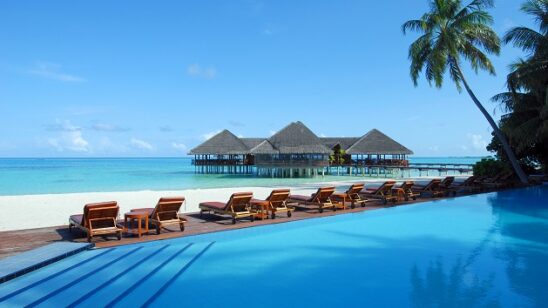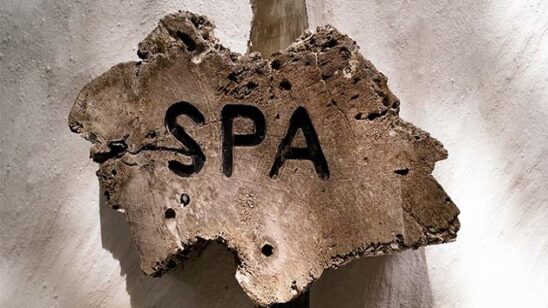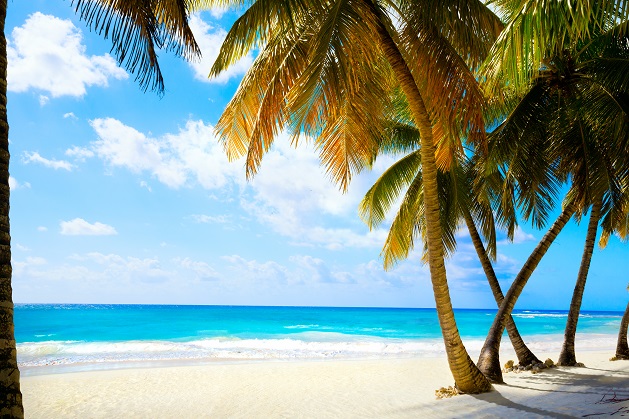
Tourist arrivals decline in January
[vc_row][vc_column width=”1/1″][vc_column_text]
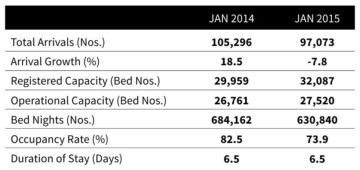 Tourist arrivals to the Maldives declined considerably in January, registering a negative annual growth rate of -7.8% compared to the same period last year.
Tourist arrivals to the Maldives declined considerably in January, registering a negative annual growth rate of -7.8% compared to the same period last year.
The Ministry of Tourism revealed this week that total arrivals stood at 97,073 visitors, down from 105,296 visitors in January 2014. “This was the fourth consecutive month where a negative growth was recorded in tourist arrivals to the country,” the ministry noted in a statement. The negative growth was also reflected in other indicators for January, the statement added.
The tourism industry recorded negative growth in November (-5.1%) and December (-1.2%) as well. Whilst the number of Russian tourists declined by 44.7% in December 2014 compared to the same period the previous year, arrivals from China and Japan dropped by 12.2% and 11.8% respectively.
In 2014, the growth rate of Chinese tourist arrivals slowed from 20% at the end of June to 9% by the end of December.
Individual markets
Despite the decline, China remained the single largest market for tourists to the Maldives last month, the ministry’s statistics showed, accounting for nearly one fourth of all arrivals.
“Arrivals to the Maldives from China started slowing down during mid-2014 and negative growths were registered since August that year,” the ministry explained.
“January 2015 was recorded as the worst performed month for the Chinese market to the Maldives so far, with a strong negative growth of 33.1%. China being the number one market to the Maldives, the negative growth registered from the market was reflected in the total arrivals to the country.”
In terms of other individual markets, Italy was the second largest market for the Maldives in January.
“The Italian market registered outstanding results during the month with an impressive +16.9% growth rate in January 2015 compared with that of January 2014 and the market share increasing to 8.3%,” the ministry observed.
“With a healthy 7.4% shares, the UK market was the third largest market to the Maldives in January 2015. The UK market has also done well with a significant growth of +6.6% during the month of January 2015 compared with that of 2014.”
With a 7.3% market share, Germany was the fourth largest market.
“Germany also posted positive results with a positive 8.7% growth rate for the month. Russia was the fifth largest market to the Maldives in January 2015 with 6% shares,” the ministry noted.
However, Russia was the worst performing market during the month, registering negative growth of 38%.
Regional markets
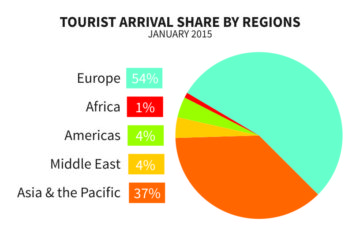 In January, Europe reclaimed top spot as the largest regional source market for tourists to the Maldives, increasing its market share from 43.9% at the end of December 2014 to 54.1% last month.
In January, Europe reclaimed top spot as the largest regional source market for tourists to the Maldives, increasing its market share from 43.9% at the end of December 2014 to 54.1% last month.
However, with a total of 52,545 tourists, the growth rate for arrivals was marginal at 0.5% on the back of a steep decline (-20.5%) in visitors from Central and Eastern Europe.
“All other sub regions within Europe posted positive growths during the month of January 2015, with East Mediterranean Europe (+24%) displaying the strongest growth and Western Europe (+1.5%) showing the weakest performance,” the ministry explained.
“Southern Europe and Northern Europe both registered double digit growths of +17.5% and +15.1% respectively, during the month of January 2015. Western Europe was the leading sub region within Europe contributing 20% to the total arrivals to the country during the month of January 2015.”
Despite negative growth, Central/Eastern Europe was the second largest sub region within Europe, accounting for 12.3% of all arrivals in January 2015.
“While Northern Europe with 10.3% shares was the third leading sub region within Europe, Southern Europe followed closely behind with 10.1% shares. East Mediterranean Europe accounted for 1.4% of all arrivals to the country in January 2015.”
Asia and Pacific
Asia and Pacific gave way to Europe in January as the largest regional source market for tourists to the Maldives, dropping its market share by 11% from December 2014 to 34% of total arrivals in January.
A total of 36,311 tourists from Asia and Pacific countries visited the Maldives last month, which was 20.6% less than January 2014.
While arrivals from North East Asia declined considerably with a negative growth rate of -28.6%, the Tourism Ministry noted that arrivals from South Asia and South East Asia grew by 15.6% and 6.7% in January.
“With over 26% shares, North East Asia remained as the largest sub region to the Maldives during the month of January 2015. Market share of South Asia was recorded to be 5.9%, and South East Asia captured 3% shares in January 2015. Oceania accounted for 1.8% of total arrivals during the month,” the Tourism Ministry observed.
On arrival numbers from other regions, the Tourism Ministry noted that the Middle East overtook the Americas to become the third largest regional source market.
While the Middle East’s market share increased from 3.1% at the end of December to 4% last month, the region registered robust arrivals growth with 38.8%.
“Americas was the second weakest performed region during the month of January 2015,” the ministry’s statistics showed.
“With a negative growth of 5.5%, market share dropped from 3.4% at the end of December 2014 to 3.1% in January 2015. Africa region performed with a positive 13.7% growth in January 2015. However, the region also recorded a drop in its market shares from 0.7% at the end of December 2014 to 0.6% in January 2015.”
Tourist facilities
In January, the Maldives had a total of 529 registered tourist facilities with a total bed capacity of 32,087, including 112 resorts (24,151 beds), 19 hotels (1,704 beds), 231 guesthouses (3,397 beds) and 167 safari vessels (2,835 beds).
“Out of these registered establishments, a total of 302 (27,520 beds) were operational during the month,” the ministry revealed.
“Operational capacity included 106 resorts with 23,247 beds, 15 hotels with 1,468 beds, 107 guest houses with 1,569 beds and 74 safari vessels with 1,236 beds.
“The total tourist bed nights of these operational establishments in January 2015 was 630,840 which was a drop (-7.8%) compared with that of January 2014. Occupancy rate also registered a decline of 8.5% during the month. However, the average duration of stay remained uniform at January 2014 level with 6.5 days, this however was an increase compared with the 6.1 days of end December 2014.”
[/vc_column_text][/vc_column][/vc_row]




